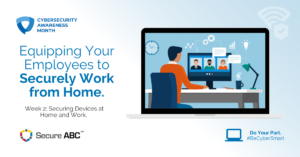NCSAM: Securing Devices at Home and Work—Equipping Your Employees to Securely Work from Home.
Did you know that seventy-four percent of companies plan to permanently shift to more remote work post-COVID? (Gartner).
However, ninety percent of IT professionals believe remote workers are not secure and seventy percent think remote staff poses a greater risk than onsite employees. (OpenVPN).

Here are a few ways you can help support a more secure work from home environment:
Use strong, complex, and unique passwords on your home router.
- Use a combination of letters, numbers, and special characters, with a minimum length of 8 characters.
- Make sure your password is unique to your router. Do not reuse passwords from other devices or logins.
Update your home router’s firmware (just as you update your other devices).
- Any devices connected to your home network may be compromised.
- This includes printers, TVs, smart home assistants, backup drives, personal devices.
Be mindful of how your company data could be exposed.
- Be aware of how you engage in conference calls that could be overheard (or what may be exposed in the background of your video calls).
- Anytime you leave your computer, lockout your screen to prevent sensitive data from being accessed.
- Be cautious when allowing access to your work PC or other work devices.
- Note what smart/listening devices you have at home and how they may be collecting company data (especially devices that are listening at all times).
- To avoid this, unplug these devices while having sensitive conversations or meetings.
Mandate security e-learning to your workforce.
- During these times, it is essential to refamiliarize yourself with these security concepts and maintain daily security hygiene.
- Get started today with SecureABC!
Do Your Part. #BeCyberSmart
Follow us on LinkedIn and never miss a post!
